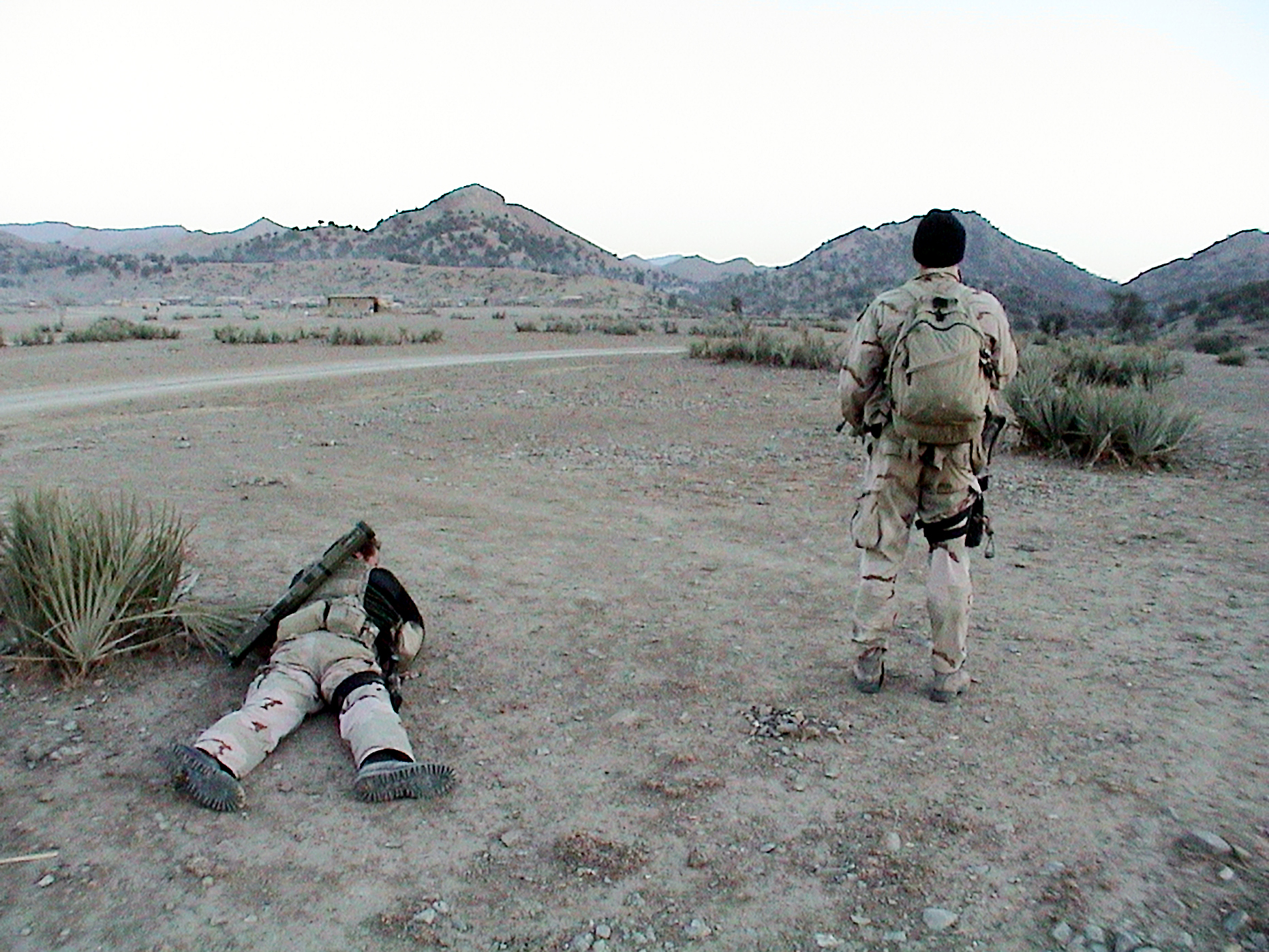|
Critical Skills Operator
A critical skills operator (CSO) is a United States Marine in the primary special operations career field of the United States Marine Forces Special Operations Command (MARSOC). CSOs, colloquially known as "Raiders", are awarded the Military Occupational Specialty 0372. CSOs are assigned to Marine Special Operations Teams (MSOT), Companies (MSOC) and Battalions (MSOBs). CSOs are trained to execute a variety of missions. Specialized training also provides capabilities in language fluency necessary for crossing cultural barriers, allowing CSOs to connect with local forces and civilians. It takes, at a minimum, four and a half years to create a Marine CSO; a Marine must have served a minimum of three years or achieved the rank of at least lance corporal before being considered a MARSOC candidate. The 0372 MOS was created on October 1, 2011. MARSOC's initial requirement for manning was 850 CSOs to outfit 48 fully operational Marine Special Operations Teams. Background After the succe ... [...More Info...] [...Related Items...] OR: [Wikipedia] [Google] [Baidu] |
Helmand Province
Helmand (Pashto language, Pashto/Dari language, Dari: ; ), also known as Hillmand, in ancient times, as Hermand and Hethumand, is one of the 34 provinces of Afghanistan, in the south of the country. It is the largest province by area, covering area. The province contains 18 Districts of Afghanistan, districts, encompassing over 1,000 villages, and roughly 1,446,230 settled people. Lashkargah serves as the provincial capital. Helmand was part of the ''Loy Kandahar, Greater Kandahar'' region until made into a separate province by the Politics of Afghanistan, Afghan government in the 20th century. It is largely populated by Pashtuns. The Helmand River flows through the mainly desert region of the province, providing water used for irrigation. The Kajaki Dam, which is one of List of dams and reservoirs in Afghanistan, Afghanistan's major reservoirs, is located in the Kajaki district. Helmand is believed to be one of the world's largest opium producing regions, responsible for aroun ... [...More Info...] [...Related Items...] OR: [Wikipedia] [Google] [Baidu] |
Billet
In European militaries, a billet is a living-quarters to which a soldier is assigned to sleep. In American usage, it refers to a specific personnel position, assignment, or duty station to which a soldier can be assigned. Historically, a billet was a private dwelling that was required to accept a soldier. Soldiers are generally billeted in barracks or garrisons when not on combat duty, although in some armies soldiers with families are permitted to maintain a home off-post. Used for a building, the term ''billet'' is more commonly used in British English; United States standard terms are ''quarters'', ''barracks'', ''Single (Soldier) Housing'' or ''Family Housing''. British history Originally, a billet (from French ) was a note, commonly used in the 18th and early 19th centuries as a "billet of invitation". In this sense, the term was used to denote an order issued to a soldier entitling him to quarters with a certain person. From this meaning, the word billet came to be loosely ... [...More Info...] [...Related Items...] OR: [Wikipedia] [Google] [Baidu] |
Sniper
A sniper is a military or paramilitary marksman who engages targets from positions of concealment or at distances exceeding the target's detection capabilities. Snipers generally have specialized training and are equipped with telescopic sights. Modern snipers use high-precision rifles and high-magnification optics. They often also serve as scouts/ observers feeding tactical information back to their units or command headquarters. In addition to long-range and high-grade marksmanship, military snipers are trained in a variety of special operation techniques: detection, stalking, target range estimation methods, camouflage, tracking, bushcraft, field craft, infiltration, special reconnaissance and observation, surveillance and target acquisition. Snipers need to have complete control of their bodies and senses in order to be effective. They also need to have the skill set to use data from their scope and monitors to adjust their aim to hit targets that are extremely f ... [...More Info...] [...Related Items...] OR: [Wikipedia] [Google] [Baidu] |
Close-quarters Battle
Close-quarters battle (CQB), also called close-quarters combat (CQC), is a close combat situation between multiple combatants involving ranged (typically firearm-based) or melee combat. It can occur between military units, law enforcement and criminal elements, and in other similar situations. CQB is typically defined as a short duration, high intensity conflict characterized by sudden violence at close range. History Close-quarters battle has occurred since the beginning of warfare, in the form of melee combat, the use of ranged weaponry (such as slings, bows, and muskets) at close range, and the necessity of bayonets. During World War I, CQB was a significant part of trench warfare, where enemy soldiers would fight in close and narrow quarters in attempts to capture trenches. The origins of modern close-quarters battle lie in the combat methods pioneered by Assistant Commissioner William E. Fairbairn of the Shanghai Municipal Police, the police force of the Shanghai Interna ... [...More Info...] [...Related Items...] OR: [Wikipedia] [Google] [Baidu] |
Special Reconnaissance
Special reconnaissance (SR) is conducted by small units, such as a recon team, made up of highly trained military personnel, usually from special forces units and/or military intelligence organizations. Special reconnaissance teams operate behind enemy lines, avoiding direct combat and detection by the enemy. As a role, SR is distinct from commando operations, but both are often carried out by the same units. The SR role frequently includes covert direction of airstrikes and indirect fire, in areas deep behind enemy lines, placement of remotely monitored sensors, and preparations for other special forces. Like other special forces, SR units may also carry out direct action and unconventional warfare, including guerrilla operations. In intelligence terms, SR is a human intelligence (HUMINT) collection discipline. Its operational control is likely to be inside a compartmented cell of the HUMINT, or possibly the operations, staff functions. Since such personnel are trained for intell ... [...More Info...] [...Related Items...] OR: [Wikipedia] [Google] [Baidu] |
United States Marine Corps Combatant Diver Course
The USMC Combatant Diver Course is taught at the Navy Diving and Salvage Training Center, Naval Support Activity Panama City, Panama City, Florida. Both of the Marine Air-Ground Task Force reconnaissance assets, FMF Recon and MarDiv Recon, widely use combatant diving. During this eight-week course, trainees are introduced to open and closed-circuit diving (using the Dräger LAR-V rebreather), diving physics and medical aid. Most of the training in combatant diving is done at night. The course provides underwater tactical training and the skills needed to successfully conduct underwater navigation for infiltration and exfiltration. The candidates negotiate long distances in open water, infiltrating by surface and sub-surface, learning to deal with the hazards of a surf zone tangle and simulated equipment malfunctions. The combatant divers course combines lecture, demonstration, and practical application in oxygen charging procedures using the USMC Oxygen Transfer Pum ... [...More Info...] [...Related Items...] OR: [Wikipedia] [Google] [Baidu] |
United States Army Airborne School
The United States Army Airborne School—widely known as Jump School—conducts the basic paratrooper (military parachutist) training for the United States Armed Forces. It is operated by the 1st Battalion (Airborne), 507th Infantry Regiment (United States), 507th Infantry, United States Army Infantry School, Fort Benning, Georgia (U.S. state), Georgia. The Airborne School conducts the Basic Airborne Course, which is open to troops from all branches of the United States Department of Defense, Reserve Officer Training Corps, and allied military personnel. History In 1940, the United States Department of War, War Department approved the formation of a test platoon of Airborne Infantry under the direction and control of the Army's Infantry Board. A test platoon of volunteers was organized from Fort Benning's 29th Infantry Regiment (United States), 29th Infantry Regiment, and the 2nd Infantry Division (United States), 2nd Infantry Division was directed to conduct tests to develop ... [...More Info...] [...Related Items...] OR: [Wikipedia] [Google] [Baidu] |
Irregular Warfare
Irregular warfare (IW) is defined in United States joint doctrine as "a violent struggle among state and non-state actors for legitimacy and influence over the relevant populations" and in U.S. law as "Department of Defense activities not involving armed conflict that support predetermined United States policy and military objectives conducted by, with, and through regular forces, irregular forces, groups, and individuals." In practice, control of institutions and infrastructure is also important. Concepts associated with irregular warfare are older than the term itself. Irregular warfare favors indirect warfare and asymmetric warfare approaches, though it may employ the full range of military and other capabilities in order to erode the adversary's power, influence, and will. It is inherently a protracted struggle that will test the resolve of a state and its strategic partners."Irregular Warfare (IW)", DoD Directive 3000.07, United States Department of Defense, 1 December 200/ref ... [...More Info...] [...Related Items...] OR: [Wikipedia] [Google] [Baidu] |
Survival, Evasion, Resistance And Escape
Survival, Evasion, Resistance, and Escape (SERE) is a training concept originally developed by the British during World War II. It is best known by its military acronym and prepares a range of Western forces to survive when evading or being captured. Initially focused on survival skills and evading capture, the curriculum was designed to equip military personnel, particularly pilots, with the necessary skills to survive in hostile environments. The program emphasised the importance of adhering to the military code of conduct and developing techniques for escape from captivity. Following the foundation laid by the British, the U.S. Air Force formally established its own SERE program at the end of World War II and the start of the Cold War. This program was extended to include the Navy and United States Marine Corps and was consolidated within the Air Force during the Korean War (1950–1953) with a greater focus on "resistance training." In 1940, the British government e ... [...More Info...] [...Related Items...] OR: [Wikipedia] [Google] [Baidu] |
Hand-to-hand Combat
Hand-to-hand combat is a physical confrontation between two or more persons at short range (grappling distance or within the physical reach of a handheld weapon) that does not involve the use of ranged weapons.Hunsicker, A., ''Advanced Skills in Executive Protection'', Boca Raton FL: Universal Publishers, , , p. 51 The phrase "hand-to-hand" sometimes includes use of melee weapons such as knives, swords, Club (weapon), clubs, spears, axes, or improvised weapons such as entrenching tools. While the term "hand-to-hand combat" originally referred principally to engagements by combatants on the battlefield, it can also refer to any personal physical engagement by two or more people, including law enforcement officers, civilians, and criminals. Combat within close quarters, to a range just beyond grappling distance, is commonly termed close combat or close-quarters combat. It may include lethal and non-lethal weapons and methods depending upon the restrictions imposed by civilian law, ... [...More Info...] [...Related Items...] OR: [Wikipedia] [Google] [Baidu] |
United States Navy SEAL Selection And Training
The average member of the United States Navy SEALs, United States Navy's Sea, Air, Land Teams (SEALs) spends over a year in a series of formal training environments before being awarded the List of United States Navy ratings, Special Warfare Operator Naval Rating and the Navy Enlisted Classification (NEC) O26A Combatant Swimmer (SEAL) or, in the case of Personnel of the United States Navy#Commissioned officer, commissioned naval officers, the List of United States naval officer designators, designation 113X Special Warfare Officer. All Navy SEALs must attend and graduate from their rating's 24-week "A" School known as Basic Underwater Demolition/SEAL (BUD/S) school, a #Parachute Jump School (3 weeks), basic parachutist course and then the 26-week #SEAL Qualification Training (SQT) (26 weeks), SEAL Qualification Training program. All sailors entering the SEAL training pipeline chosen by Naval Special Warfare Command must also attend the six-month SEAL specific Special Operations T ... [...More Info...] [...Related Items...] OR: [Wikipedia] [Google] [Baidu] |







